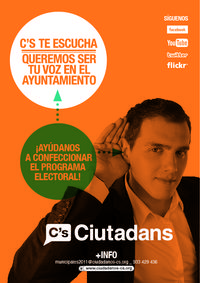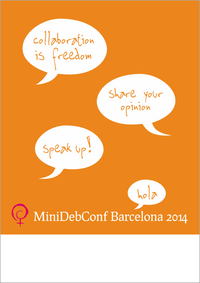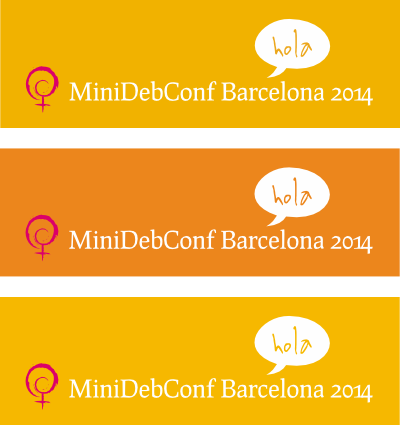My life with design, visual communication, art - and sustainability.
A visit at Makvärket in Knabstrup, close to where we used to live, was the height of my week.
I wanted to share the spirit of that place with my project peers from Mejeriet. I wanted to make them understand that the building is far from being in a shape "too bad to fix", or "a project too big to realize". They got it.
A lot had been renovated since I was there a couple of years ago. An assembly hall. A huge kitchen. Dormitories. New toilets. And a roof and three portals in the passage between two huge buildings, bringing light and air to the core of the building complex. Incredible! And so beautiful.
I didn't take pictures. I can't seem to be able to find the old ones either. I'll go back soon.
I'd like to invite everybody to see this online talk with Aral Balkan.
In his talk he explains everything I believe is important for software development: The 1 % surveilling our every move through online services. How we can take back our human and democratic rights through design of decentralised services. He advocates for Ethical Design, which means designing technology that is "decentralised, private, open, interoperable, accessible, secure and sustainable", "functional, convenient and reliable" as well as "delightful".
It's everything I believe in, beautifully put.
He is an english designer, software developer and human data rights activist. He moved from the UK because of new data anti encryption laws there and is currently living in Malmö. He and his wife Laura have a work platform Ind.ie, (which reminds me of the potential in CouchDesign). They've created an app, Better, that stops you from being tracked while surfing the web.
Watch the talk here: https://ind.ie/beyond-the-clouds/
Jonas heard about Aral Balkan and the concept of Ethical Design at the Chaos Pilot University, while presenting himself and the network Homebase he runs there to the new team of students. His colleague Anders pointed towards the talk as further reference for the students.
It strikes me as brilliant in its clear and straightforward communication, and it could be a great source of inspiration for Debian Design.
This week I've spent two days working to bring down the update waiting time for the editing role on the website Byvandring.nu. I've created a first draft of a tag pool for Vejviseren, the blog of the site. Created with Ikiwiki. I also fixed a few style issues have annoyed my eye for a while.
Like many other projects of mine, that website is a work in progress, a prototype, a place where I practice and learn. There are things that work well, others don't exactly work well. The author uses and promotes the site actively, and sometimes I even get to do some artwork. It's essentially gratifying.
And then the annoyances. I am on them with renewed enthusiasm.
However, I need to work on my tendency to get annoyed with all the things that could be better. My designs, my routines, my skills, the services I use. I sometimes take it out on Jonas, and I did this week. However, I appreciate being able to work like I do with the things I work with.
I've spent two other days on a brochure design to be presented next week. I want to share more of my work, but I better wait 'till a later phase of this particular design.
During the week I had half a day in Holbæk. I went for a meeting with a former colleague from the small publishing group Fjordliv, I was a member of a few years back (it's closed now). She has a book on the way, and invited me to set it up for her, which I'll be happy to do. I love designing books.
This week my choir, Orøkoret, started the new season. Every thursday evening I'll be occupied singing and socializing with other local voices, endorphins flowing.
It's been a rainful week, and I have spent about an hour daily cutting grass with scythe, raking and moving those small stacks of grass or pulling burning nettles out of the soft, wet soil.
I've been looking forward to a lamp making course Saturday, but we were supposed to be outside, and it was raining, starting half an hour before and continuing for the rest of the day, so we called it off, and will try again next saturday.
What's next
Coming up is a meeting with my co-developer of design solutions at Friis-Holm Chocolate. Mikkel Juul. He is hard to get at, because of the busy life at the chocolate factory and the many conventions they attend. So now we have decided to meet regurlarly, but shortly, every other week. I'm convinced it will speed up our development time and also be even more fun and interesting. We have a lot of designs in development, but I'm most excited to show him the brochure proposal.
Monday I'll join a course on sociocratic methods in local development projects. This is related to the project Mejeriet.
Yoga classes start tuesdag. It's my intention to get back into my fleeing habit of doing the five tibetans every morning, and my yoga teacher is a strong advocate of that in particular. We always start our sessions with a round, so I get a firm push in the back every week.
A meet-up in the local artist network is scheduled tuesday evening. We have an exhibition in December, and two books on the way, which I am designing, and have been putting off for a month now. The time has finally arrived to restart those processes.
Saturday will be the lamp workshop, hopefully.
Uniform is a project in Debian Design. Uniform makes it possible to make a unified look and feel with a clear identity in Debian packages with user interface. The Uniform package can offer system wide defaults for other packages in order for them to alter their own default design choices. Uniform applies design traits across desktop environments, window managers, applications and services at the moment of installation. The tool is handy for customized blends and forks of Debian - and for the next stable version of Debian.
Starting with color and typeface schemes, the scope of the package can potentially expand to include other configuration issues like choice of widget theme, icon theme, wallpaper and voice management.
The Uniform package converts design configurations into different programming languages.
Initial choices prompted by Uniform during installation
- Title
- Tagline
- Logo
- Profile
- Wallpaper
- Color
- Typography
One application of a color or a set of colors doesn't necessarily mix well into the next To overcome some of these obstacles to uniformity, a set of semantics is recommended.
Ressources for semantic expressions of color and typographic design
- SASS ressources
- The Google Material Design project
- Bootstrap
Saturday is my cleaning day. I've recently started expanding the cleaning concept to my digital and management clutter. So it's a day for tying loose ends. Sort, toss, tidy. Finish and archive.
This week has been about initiating the setup for our intern as well as developing and finishing a handfull of print jobs, a few still pending, needing to get done before monday morning. Work seems to come in waves.
I've agreed to read and correct spelling and markup mistakes in a client's blog, possibly providing him with graphics (already did the creative part of that). The task could be postponed, but it's better to do it ahead to take out stress of dealing with eventual failures and mistakes. It's never fun to do that last minute before - or even after the newsletter is sent out. Visit the blog Vejviseren at Byvandring.nu this Monday at noon (it's in Danish).
I'll start a new habit of backing up and updating my computer on Saturdays today. We use git for version control of our web sites, and I've started using it for my design documents, but lacked the habit tied to using it in that area of my work, so the archive is not up to date, and frankly, it's a mess, tying my effectiveness down when searching for reference files for new jobs for the same client.
If I can squeeze it in, it would be nice to spend some time in the garden, it needs tending. But it's probably better to postpone that for tomorrow or use those tasks for a productive break from screen time. Compost, strawberry plants and the usual removal of a hundred out of thousands of small trees.
Touching issues
Following a conversation with Jonas about it, pointing towards CouchDesign, here are some of the subjects I've been touching with my client work this week, each somehow related to our pending's list:
- layered pdf with pdf inclusion
- color management (for press and for print)
- bar code generation
- process documentation
- archive structure
- key signing (using caff)
- design management
- licensing
- slippy maps
- scss
- vector drawing optimization
- documenting work, tracking
Demerits
I sent an advent calendar to the printers' shop without the date numbers. I somehow tied the design of that part to the producer, subconsciously presuming they came with the diecut drawing. I never even gave it a thought, and was reminded by the client asking.
I struggled more, however, with dealing with a reported color failure on another job. It's been a while since I've had issues with that, and it took me by surprise. It was an office printer job. Jonas had yet another long read to deepen his already rather extensive knowledge on color management and to brush up on what to take into consideration. I've successfully taken care of it from his hints, and now I/we are going to document what I did.
Documenting manifesto of today
Documenting a routine is not the same as improving it, even if it needs it. Confronted with an unfinished or dormant project, issue or bug, it is not the right time to deal with it. Simply document it.
After telling a friend about our desktop distribution design oriented journey through India last december-february, she got her son interested in our activities. We met in spring, and soon we got an internship arranged and approved, starting late this summer.
His name is Nikolai. He is studying computer science at Zealand Institute of Business and Technology in Roskilde.
Jonas and I had a deep look into our pending projects in our partnership platform Couchdesign. We believe we have some interesting projects for him to work with.
We have a strong intention to document and sharpen our communication effort concerning the subjects we touch in our work and life. My first instinct is to blog, since writing is a good way for me to clarify my thoughts. We have started collecting notes about our digital routines. We are getting ready to give talks about free software and free (and libre) graphics. Few people know enough to see the endless possibilities in open collaboration and in free software.
We will invite Nikolai to understand and create setup and user documentation for some of our routines, then work to improve them. We have picked four issues for him to dig into:
- Collaborative communication online.
- ShowMeBox. Testing a Pure Debian Blend for a tiny computer.
- Print. Do we need to buy a new printer or can we solve our current printer problems? Research and share findings on a global database.
- Music - shared storage and accessibility to home server.
Our friend and free software colleague Vasudev in Bangalore is invited to participate in our regular online meetings.
It doesn't matter if I'm messy or lazy or don't reach my goals, or if I do. What matters is to feel good about what I do.
I feel good when I do what's important to me. Resistance is about uncertainty. It's natural. So I try to relax about it. Take a bite and try it out anyway. Or take a break before I dive in.
Since the MiniDebConf Jonas and I have been travelling in Spain, France and finally staying in Belgium for a week, getting some work done. It's been harder than imagined to work during travel. I haven't exercised either, and regained at least three of four kilos I spent much time and effort getting rid in the year preceding. I thrive in my home and find it hard to keep my own time and focus when I am deprived of my own space.
It was challenging to give a talk, "Why aren't more designers using Debian or working for Debian", my first public talk. I've been working to recapture my points in writing, to make a stronger statement, but I seem to blur my own views with conflicting ones, and I'm loosing momentum every day.
One of my reasons for speaking up was to do it even though I'm not at trained speaker and have "nothing" to contribute but my opinions from the angle of a user that happens to be a designer. Not claiming to be a superior designer, but one that would like to contribute if it was easier to figure out how. And since the community wants to encourage designers to contribute to the Debian project, I figured it to be a good idea to talk about how this has been challenging to me as a dedicated user and completely out of the question for any other designer I know - or knew before the minidebconf. No reseach, no scientific proofs, just my wiew from my "dumb user" and designer's perspective.
I saw one single attendant rolling his eyes during my talk. I didn't care at that time, but I've given that look more consideration than the people approaching me after the talk, saying thank you for voicing their opinions and thoughts. I think that's absolutely astonishing and at the same time it's just typically me. It makes me angry, first with myself for not speaking to this man's perception of things, then with myself for not just letting go of that image. I'm really glad that so many seemed to listen with curiosity and interest. What if one more - or half of the auditorium - had rolled their eyes? I don't like to feel that vulnerable.
The truth is, though, that I'm really not. I gave the talk against my fear of failure and public humiliation and I'm convinced that my thoughts and actions matter, just as anybody's does, if we dare to say what's on our minds and to take action. I believe it's in anybody's power to "make a difference" and even "change the world" - at least in a small way. I guess that's one of the underlying reasons to be a designer in the first place. That is quite a strong position to take.
I've created the wikipage http://wiki.debian.org/Design - well knowing that design is a word with many meanings. Everything is design. Since the talk I've been in doubt about that page. About the project, my aim with it, what to do about it, how to move on with just a tiny babystep, and I realise that I'm simply afraid to be disturbing someone's peace, making people angry or roll their eyes at my fumbling attempts to figure out in public what can be done to make a thriving community of designers collaborating with coders to make better, more usable and attractive software in the free, wide world. I'm starting a design process, not presenting a perfect, finished solution.
Now, having put these thoughts into words, perhaps, my mind will be somewhat appeaced and let me move on with my intended tasks of cultivating that acclaimed space in the Debian information jungle into a friendly and welcoming place with info that makes it easier to be a contributing designer in Debian.
I've been asked to make another design proposal for the Minidebconf. People have been brainstorming. I could have asked them to do that months ago. I didn't, because I was working with my own ideas.
We need to know who and what we are aiming at with the graphic communication, as well as with the conference. Who is the design for? What should they do? Why? Who is the conference for? Who should be interested?
Is the design for people in Barcelona only? Is it for women only? Is it for current developers? Or is it for local politicians? Male or female? Students? - only? Does the communication have other goals than getting people at the venue? Should the design reflect the organizers - or rather not? Does the geography have to play a role in the visual imagery?
These are questions that should always be asked. I made the mistake to answer a lot of the questions myself, based on my second hand knowledge and guesses. A common mistake, I've made before and will probably make again. I'm used to working on my own, that's my poor excuse.
To my mind, the gathering, the meeting in the flesh and the communication and sharing of knowledge, is far more important than local landmarks.
I don't feel that strongly for a location oriented identity design. La Sagrada Familia doesn't have anything to do with a gathering for free software development, does it. How?
Oh, that was the minidebconf in Barcelona
Oh, that was the minidebconf arranged by Debian Women
Oh, that was the minidebconf that made a point out of being inclusive
Oh, that was the minidebconf that…
The identity design might have more to do with support to the local group than with any of the other aspects of the conference. Interesting.
This table of colors shows different ways a blue and a purple
could go. I put the green colors there to have more options
covered for the discussion today. You can see how the different
hues interacts with the red of the logo.
The colors can be referred to like this: B3, C6, A4 etc.
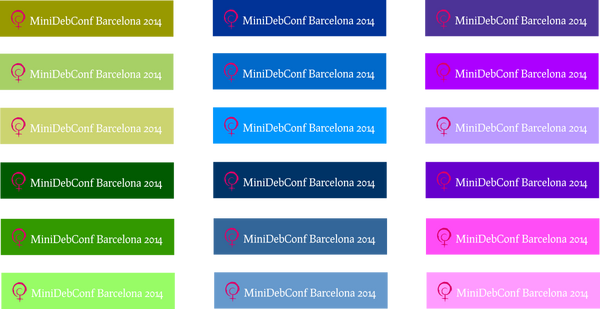
Click on the image for full size version.
Here is an idea based on all the purple colors. Fun, uplifting,
feels like many voices. Too many colors for T-shirt print, maybe:
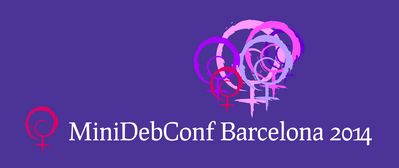
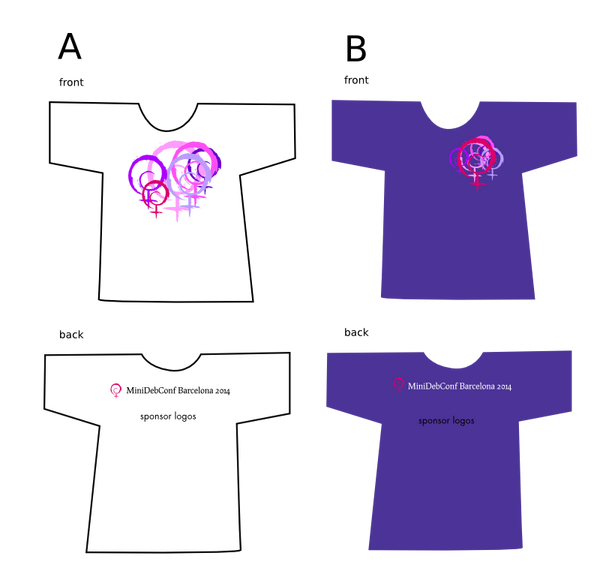
Here is some ideas of how to implement a minimalistic
solution that I recommend for minidebconfs:
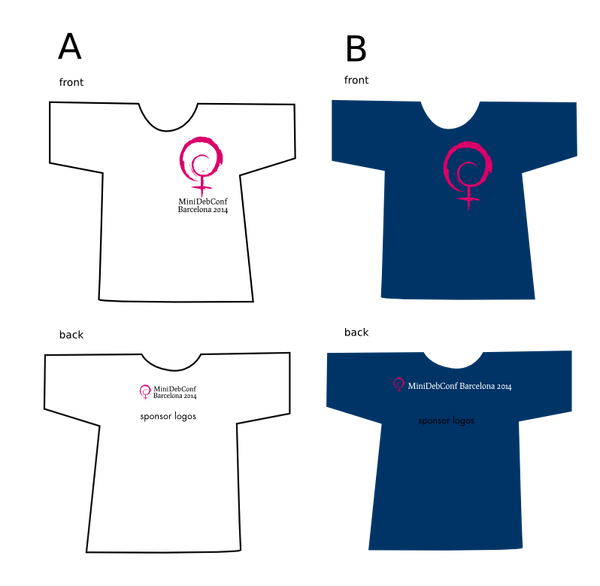
My suggestion is that the banner (and everything else displaying the event) has the logo of the organizers placed on it. The font used for headlines etc is semantically of another nature than the logo, though it could be the same. I prefer neutral fonts, that can be reused by the next minidebconf, and I suggest a sans serif font. A condensed font makes huge display easier to fit.
Don't be confused by displayfonts, I aim to show you that type
alone speaks loudly, and if this typography should be recycled,
we should not choose one of them, but go with the "neutral" sans
serif.
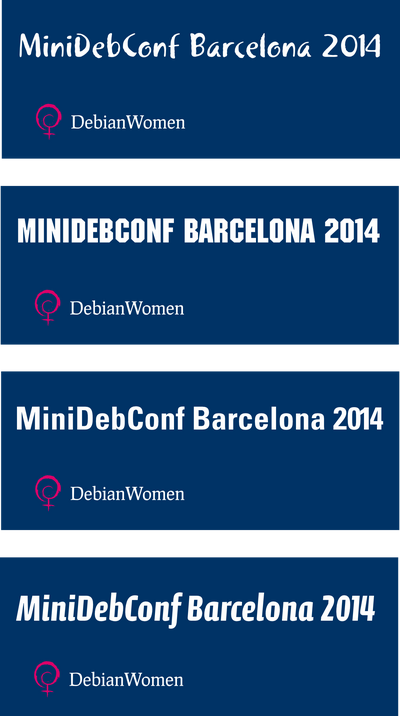
I need suggestions of free and good sans serif fonts.
My proposal for visual design for the MiniDebConf has been received well. People seem to like the general idea, which worried me the most. If people hated that idea, I'd have to go back and cook something up on Miró…
However, organizers in Spain do worry that the visual expression will be confused with that of a local political party.
I see no danger of that. They use speech bubbles and orange. So does the telecompany Orange (if it still exists) - and Ubuntu.
By the way, I see in this small size that my new choice of font for the speech bubbles is too weak. It needs more work.
It's been suggested I try out a brighter orange.
The color in the middle is my original choice, the one at the top is fine, but you can almost tell no difference, when they are not placed closely together.
The same danger of confusion will (not) be there with any orange from "curry" to "crocus".
I show the color in the bottom because it makes it evident how narrow the gap between these colors is - there is very tight room for adjustments. Yellow is too bright and cheap looking, like a discount sign color.
I've looked into other colors, but so far I've not found any good replacement, since I no longer have any gut feeling to hang my hat on, except for the Debian logo color - they have to be a good match. I know I'm free to do whatever, Jonas just reminded me, but of all the colors in the World, thinking of Spain, I only feel orange. Not blue, not green, not purple. Red is already used. Yellow looks cheap. A dusty palette is not uplifting…
I could choose a pink, and that would actually be fun. But pink is not serious. Pink can't be taken seriously. Like women can't?
OK, now it's gotta be pink!
Well, I'm not really serious now.
The serious thing to do for me now will be to watch some Spanish movies to get a new gut feeling about Spain. A dosis of Almodóvar would be suitable. Alternatively I must chat with some Spanish friends.
But maybe, just maybe, the Barcelona organizers will be just as happy with the new orange color as I am. Life can sometimes be that easy.
